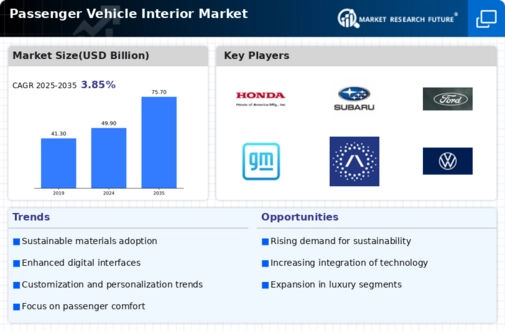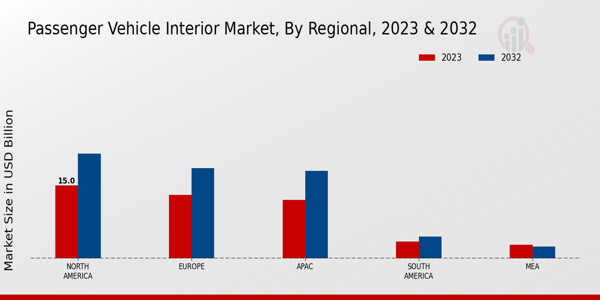Regulatory Compliance
Regulatory compliance is a crucial factor influencing the Global Passenger Vehicle Interior Market Industry. Governments worldwide are implementing stringent safety and environmental regulations that manufacturers must adhere to. For example, regulations concerning the use of hazardous materials in vehicle interiors are prompting companies to innovate and develop safer alternatives. This compliance not only ensures consumer safety but also enhances brand reputation. As manufacturers invest in meeting these regulations, the market is likely to witness sustained growth, driven by the need for compliance and innovation in vehicle interior design.
Sustainability Trends
Sustainability is emerging as a pivotal driver within the Global Passenger Vehicle Interior Market Industry. Consumers are increasingly favoring eco-friendly materials and production processes, prompting manufacturers to adopt sustainable practices. For example, the use of recycled plastics and organic materials in vehicle interiors is gaining traction. This shift not only aligns with consumer preferences but also addresses regulatory pressures for reduced environmental impact. As a result, the market is expected to grow at a CAGR of 3.85% from 2025 to 2035, reflecting the industry's commitment to sustainability and innovation.
Market Growth Projections
The Global Passenger Vehicle Interior Market Industry is poised for substantial growth, with projections indicating a market size of 49.9 USD Billion in 2024 and an anticipated increase to 75.7 USD Billion by 2035. This growth trajectory suggests a compound annual growth rate (CAGR) of 3.85% from 2025 to 2035. Such figures reflect the industry's resilience and adaptability in response to evolving consumer preferences and technological advancements. The market's expansion is likely to be driven by various factors, including increased demand for comfort, sustainability, and advanced technology in vehicle interiors.
Rising Disposable Incomes
Rising disposable incomes in emerging markets are significantly impacting the Global Passenger Vehicle Interior Market Industry. As consumers in these regions gain more financial flexibility, they are increasingly investing in vehicles that offer advanced interior features and technologies. For instance, the demand for premium interiors with high-quality materials and advanced infotainment systems is on the rise. This trend is expected to contribute to the overall market growth, as manufacturers tailor their offerings to meet the preferences of these consumers. The increasing purchasing power in emerging economies may further accelerate the market's expansion.
Technological Advancements
The Global Passenger Vehicle Interior Market Industry is experiencing a surge in technological advancements, particularly in infotainment systems and connectivity features. Innovations such as touchscreens, voice recognition, and smartphone integration are becoming standard in modern vehicles. For instance, the integration of advanced driver-assistance systems (ADAS) enhances safety and user experience. As consumers increasingly demand these features, the market is projected to reach 49.9 USD Billion in 2024, indicating a robust growth trajectory. This trend suggests that manufacturers must prioritize technology to remain competitive and meet evolving consumer expectations.
Consumer Preferences for Comfort
The demand for enhanced comfort in vehicle interiors is a significant driver in the Global Passenger Vehicle Interior Market Industry. Consumers are increasingly prioritizing features such as ergonomic seating, climate control, and noise reduction. For instance, luxury brands are incorporating high-quality materials and customizable options to cater to this demand. This focus on comfort is likely to influence purchasing decisions, as consumers seek vehicles that provide a superior driving experience. Consequently, the market is projected to expand, with a potential valuation of 75.7 USD Billion by 2035, underscoring the importance of comfort in vehicle design.


























